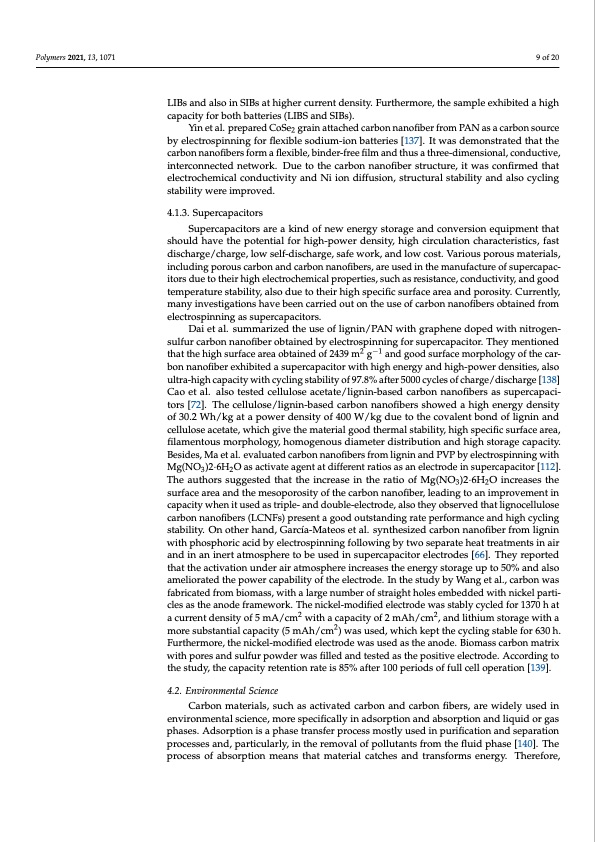
PDF Publication Title:
Text from PDF Page: 009
Polymers 2021, 13, 1071 9 of 20 LIBs and also in SIBs at higher current density. Furthermore, the sample exhibited a high capacity for both batteries (LIBS and SIBs). Yin et al. prepared CoSe2 grain attached carbon nanofiber from PAN as a carbon source by electrospinning for flexible sodium-ion batteries [137]. It was demonstrated that the carbon nanofibers form a flexible, binder-free film and thus a three-dimensional, conductive, interconnected network. Due to the carbon nanofiber structure, it was confirmed that electrochemical conductivity and Ni ion diffusion, structural stability and also cycling stability were improved. 4.1.3. Supercapacitors Supercapacitors are a kind of new energy storage and conversion equipment that should have the potential for high-power density, high circulation characteristics, fast discharge/charge, low self-discharge, safe work, and low cost. Various porous materials, including porous carbon and carbon nanofibers, are used in the manufacture of supercapac- itors due to their high electrochemical properties, such as resistance, conductivity, and good temperature stability, also due to their high specific surface area and porosity. Currently, many investigations have been carried out on the use of carbon nanofibers obtained from electrospinning as supercapacitors. Dai et al. summarized the use of lignin/PAN with graphene doped with nitrogen- sulfur carbon nanofiber obtained by electrospinning for supercapacitor. They mentioned that the high surface area obtained of 2439 m2 g−1 and good surface morphology of the car- bon nanofiber exhibited a supercapacitor with high energy and high-power densities, also ultra-high capacity with cycling stability of 97.8% after 5000 cycles of charge/discharge [138] Cao et al. also tested cellulose acetate/lignin-based carbon nanofibers as supercapaci- tors [72]. The cellulose/lignin-based carbon nanofibers showed a high energy density of 30.2 Wh/kg at a power density of 400 W/kg due to the covalent bond of lignin and cellulose acetate, which give the material good thermal stability, high specific surface area, filamentous morphology, homogenous diameter distribution and high storage capacity. Besides, Ma et al. evaluated carbon nanofibers from lignin and PVP by electrospinning with Mg(NO3)2·6H2O as activate agent at different ratios as an electrode in supercapacitor [112]. The authors suggested that the increase in the ratio of Mg(NO3)2·6H2O increases the surface area and the mesoporosity of the carbon nanofiber, leading to an improvement in capacity when it used as triple- and double-electrode, also they observed that lignocellulose carbon nanofibers (LCNFs) present a good outstanding rate performance and high cycling stability. On other hand, García-Mateos et al. synthesized carbon nanofiber from lignin with phosphoric acid by electrospinning following by two separate heat treatments in air and in an inert atmosphere to be used in supercapacitor electrodes [66]. They reported that the activation under air atmosphere increases the energy storage up to 50% and also ameliorated the power capability of the electrode. In the study by Wang et al., carbon was fabricated from biomass, with a large number of straight holes embedded with nickel parti- cles as the anode framework. The nickel-modified electrode was stably cycled for 1370 h at a current density of 5 mA/cm2 with a capacity of 2 mAh/cm2, and lithium storage with a more substantial capacity (5 mAh/cm2) was used, which kept the cycling stable for 630 h. Furthermore, the nickel-modified electrode was used as the anode. Biomass carbon matrix with pores and sulfur powder was filled and tested as the positive electrode. According to the study, the capacity retention rate is 85% after 100 periods of full cell operation [139]. 4.2. Environmental Science Carbon materials, such as activated carbon and carbon fibers, are widely used in environmental science, more specifically in adsorption and absorption and liquid or gas phases. Adsorption is a phase transfer process mostly used in purification and separation processes and, particularly, in the removal of pollutants from the fluid phase [140]. The process of absorption means that material catches and transforms energy. Therefore,PDF Image | Electrospun Carbon Nanofibers from Biomass and Biomass Blends

PDF Search Title:
Electrospun Carbon Nanofibers from Biomass and Biomass BlendsOriginal File Name Searched:
88145ac687f0c36c7096f236fabe2cba856c.pdfDIY PDF Search: Google It | Yahoo | Bing
Sulfur Deposition on Carbon Nanofibers using Supercritical CO2 Sulfur Deposition on Carbon Nanofibers using Supercritical CO2. Gamma sulfur also known as mother of pearl sulfur and nacreous sulfur... More Info
CO2 Organic Rankine Cycle Experimenter Platform The supercritical CO2 phase change system is both a heat pump and organic rankine cycle which can be used for those purposes and as a supercritical extractor for advanced subcritical and supercritical extraction technology. Uses include producing nanoparticles, precious metal CO2 extraction, lithium battery recycling, and other applications... More Info
| CONTACT TEL: 608-238-6001 Email: greg@infinityturbine.com | RSS | AMP |